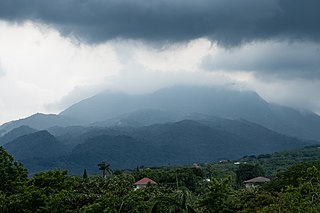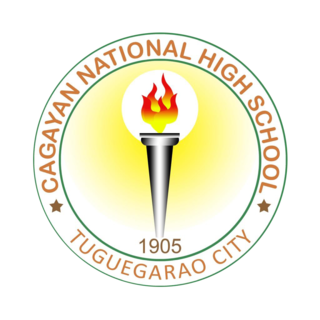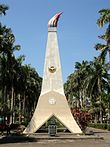History
Classes in the UPRHS were first held in the present rooms of the Department of Agricultural Economics. A concrete one-story building with a multi-purpose hall, two classrooms, a kitchen and a sewing room was constructed in 1931. At present the building now houses the Southern Tagalog Agricultural Resources, Research and Development Consortium Office.
With the institution of Home Economics in 1939, the school had two curricula—the Boys' and the Girls' Curricula—which were basically the same except that the latter had home economics.
During the Japanese regime, the school continued functioning with the major curricular changes in the replacement of English and U.S. History with Japanese, Filipino, Language, Reading, and Character Education.
Until the latter part of the 1950s, the UP Rural High School served as a practice school for majors in Agricultural Education. With the abolition of the certificate program for Junior-Agriculture teachers, the adoption of the eight-week off-campus practice teaching, and the diminution of the twenty-hours-a-week field work, the school gradually gave up its original function.
In 1960, the vocational curriculum was changed to College Preparatory by adding more academic courses (English, Mathematics, Science, History) and shortening the periods in Agriculture and Home Economics to only four hours and twenty minutes a week. The Boys and Girls Curricula were combined into one in 1969.
In December 1970, the UPRHS moved to the newly renovated Women's Dorm located in front of the St. Therese of Child Jesus Parish. The building provided a bigger library, chemistry laboratory, a kitchen, a sewing room, eight classrooms and faculty offices.
The School has implemented the 1960 curriculum up to 1999 with the replacement of the traditional history courses with Social Studies I (The Community), Social Studies II (The Nation), Social Studies III (Economic Development & Program), and Social Studies IV (The World: A Cultural Perspective), as well as the inclusion of the Youth Development Program (YDT) which covers Scouting, Physical Education, Music, and Citizen Army Training (later replaced by the Preparatory Military Training or PMT) as required by the Department of Education and Culture in 1972.
Since 1998, students, as prescribed by the present Department of Education, Culture & Sports, are now taking up Economics in their fourth year. World History, on the other hand, is now being offered to the juniors.
In 1979, Agriculture and Home Economics periods were further reduced to four hours a week. A change in the Mathematics curriculum was also implemented with the replacement of the traditional Mathematics courses with Math I (Modern Math), Math II (First Course in Algebra), Math III (Geometry), Math IV-A (Second Course in Algebra, part I), Math IV-B (Second Course in Algebra, part II), Math V (Introduction to Trigonometry), Math VI (Advanced Algebra), and Math VII (Introduction to Statistics). Advanced Mathematics classes have been offered starting school year 1980–81 to students who rate high in the math test of the entrance exam and later qualify in a test given to them.
In the school year 1999–2000, the Mathematics department proposed an amendment to the Math curriculum of UPRHS. To be implemented starting school year 2000-2001 are the courses Math 3-A (Advanced Algebra, formerly Math IV-A and IV-B) and Math 3-B (Geometry, formerly Math III). On the other hand, 4th year Math courses such as Math 4-A (Trigonometry with Introductory Calculus, formerly Math V & VI) and Math 4-B (Introduction to Statistics, formerly Math VII) will be offered starting school year 2001–2002.
The Science Curriculum has also been revised with a corresponding increase in number of credit units and number of class hours per week from three hours and thirty minutes per week with one unit credit to six hours per week with two units credit.
On June 21, 1999, UPRHS moved to its new home at Brgy. Paciano Rizal, Bay, Laguna. Since 2005, the school has been under the jurisdiction of the UPLB College of Arts and Sciences and is still recognized "as a state university high school of high academic achievement and of strong commitment to its continuing task in molding the youth". [1] [2]
On May 1, 2003, with the institution of the Bachelor of Science in Mathematics and Science Teaching Program, the administration of UP Rural High School was turned over to the College of Arts and Sciences (CAS), UPLB. Under the headship of CAS, UPRHS has strengthened its place in the university as BS MST students majoring in biology, Chemistry, Physics, and Mathematics undertake their field studies and teaching internship at UPRHS under the monitoring of the UPRHS faculty.
In 2013, UPRHS took the challenge of improving its curriculum in preparation for the implementation of the Enhanced Basic Education Program, otherwise known as the K-12 program. [3]
UPRHS started the implementation of the Senior High School program in 2016. The said SHS program offers two strands of academic track curriculum: STEAM (Science, Technology, Engineering, Agriculture and Mathematics), and GAS (General Academics) with sub-strands on Business Studies and Humanities / Social Science. The school calendar shift was also approved by the Board of Regents the same year, thus making the school year open in August and end in May of the following year.













